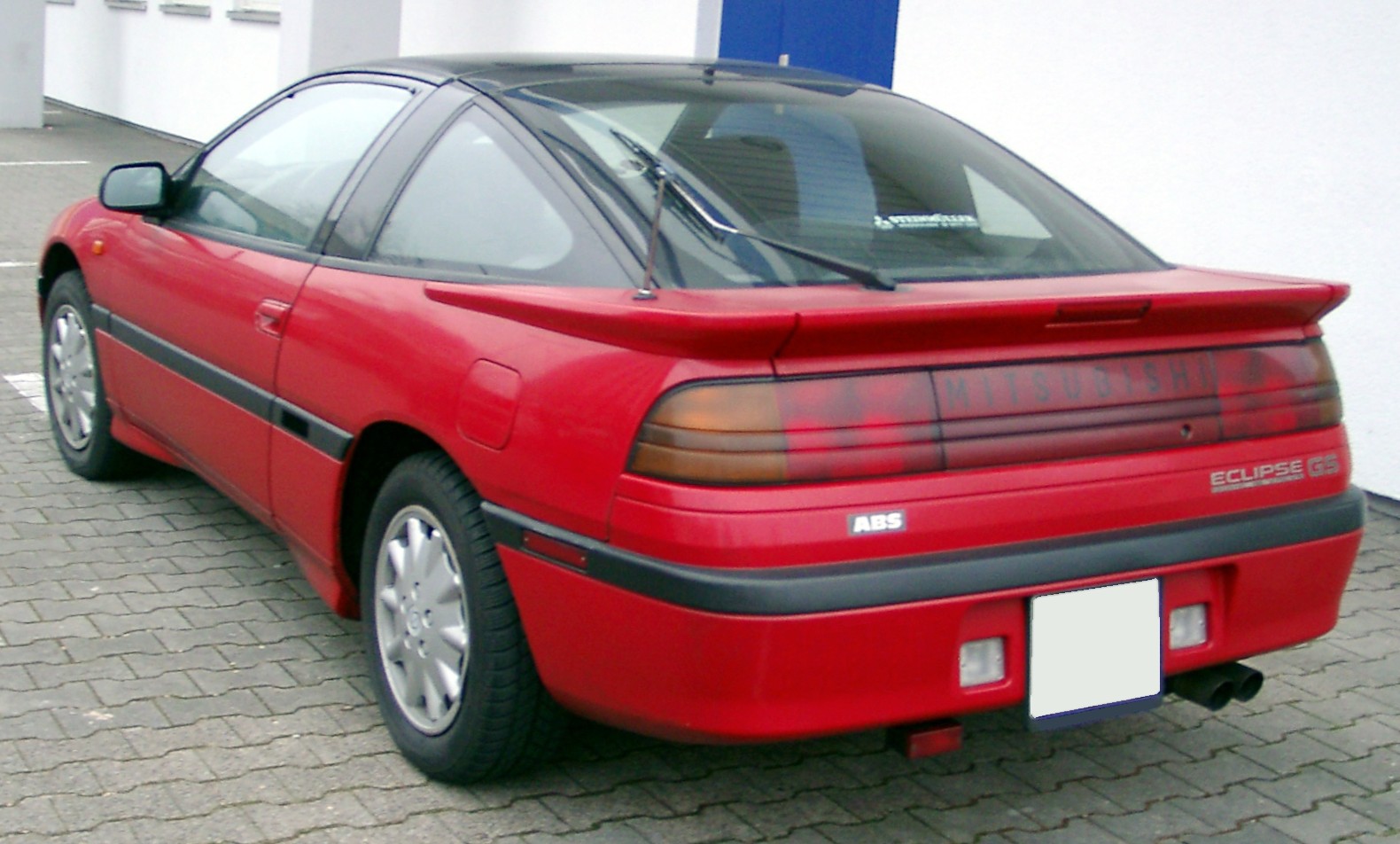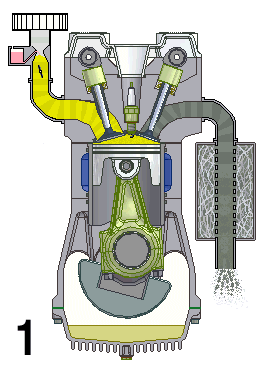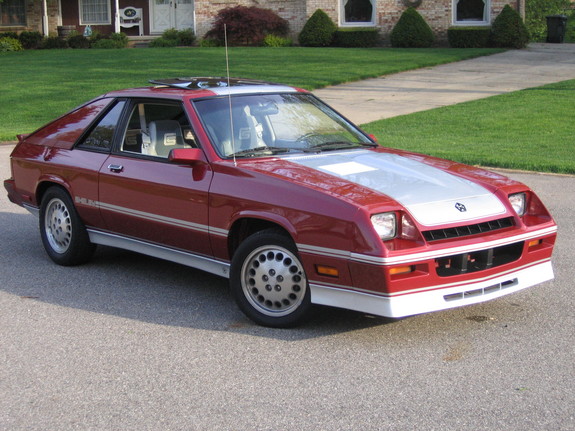|
Dodge Daytona
The Dodge Daytona is an automobile which was produced by the Chrysler Corporation under their Dodge division from 1984 until 1993. It was a front-wheel drive hatchback based on the Chrysler G platform, which was derived from the Chrysler K platform. The Chrysler Laser was an upscale rebadged version of the Daytona. The Daytona was restyled for 1987, and again for 1992. It replaced the Mitsubishi Galant-based Challenger, and slotted between the Charger and the Conquest. The Daytona was replaced by the 1995 Dodge Avenger, which was built by Mitsubishi Motors. The Daytona derives its name mainly from the Dodge Charger Daytona, which itself was named after the Daytona 500 race in Daytona Beach, Florida. History The Daytona originally used the 2.2 L Chrysler K engine in naturally aspirated or turbocharged form. Power outputs are respectively. The , 2.5-litre K engine was added for 1986. In 1985, the 2.2-L Turbo I engine's horsepower was increased to . The 1984 Daytona was avail ... [...More Info...] [...Related Items...] OR: [Wikipedia] [Google] [Baidu] |
Mitsubishi Eclipse
The Mitsubishi Eclipse is a sport compact car manufactured and marketed by Mitsubishi Motors, Mitsubishi over four generations for model years 1989-2011. A convertible body style was added during the 1996 model year. The first two generations were marketed simultaneously as Rebadging, rebadged variants, including the Eagle Talon and Plymouth Laser — and were a byproduct of Mitsubishi Motors and Chrysler Corporation's close alliance. Their partnership in turn gave rise to Diamond-Star Motors (DSM). In Japan, the first two generations were sold at a specific Japanese retail chain called ''Mitsubishi Motors#Japan Sales Channels, Mitsubishi Car Plaza''. The third, 2000–2005 generation shared an extended wheelbase variant of their platform with the Chrysler Sebring and Dodge Stratus. In May 2005, the fourth, and final generation Eclipse was introduced, replacing the Chrysler platform used for the third generation with the Mitsubishi PS platform, PS platform. According to Mi ... [...More Info...] [...Related Items...] OR: [Wikipedia] [Google] [Baidu] |
Chrysler G Platform
The K-car platform was a key automotive design platform introduced by Chrysler Corporation for the 1981 model year, featuring a transverse engine, front-wheel drive, independent front and semi-independent rear suspension configuration—a stark departure from the company's previous reliance on solid axle, rear-drive unibody configurations during the 1970s. Derived from Chrysler's L-cars, the Plymouth Horizon and Dodge Omni, the platform was developed just as the company faltered in the market, at first underpinning a modest range of compact/mid-size sedans and wagons—and eventually underpinning nearly fifty different models, including all-wheel drive variants—and playing a vital role in the company's subsequent resurgence. Common platforms The use of a common platform is a widely used practice for reducing the number of parts and engineering time. Before creating the K platform, Chrysler was building vehicles on a small number of common platforms (e.g. F/L/J/M and R), but t ... [...More Info...] [...Related Items...] OR: [Wikipedia] [Google] [Baidu] |
Car And Driver 10Best
''Car and Driver'' 10Best is a list annually produced by ''Car and Driver'' (''C/D'') beginning in 1983, nominating what it considers the 10 best cars of the year. ''C/D'' also produced the 5Best list, highlighting what it considers the five best trucks of the year. All production vehicles for sale in that calendar year are considered with these recent restrictions: # The vehicle must be on sale by January # It must be priced below 2.5 times the average price of a car that year # The manufacturer must provide an example for testing # Only substantially changed or new vehicles and the past year's 10 best winners are nominated The magazine sometimes selects a specific trim and other times a whole family of vehicles. Tuv Top Models From the start of the 10Best in 1983 through 2023, the following models were represented on the 10Best lists the most years. 1983 For the 1980s, Car and Driver picked four domestic and six import cars. Fastest car tested: Jaguar XJ-S ''HE'', 14 ... [...More Info...] [...Related Items...] OR: [Wikipedia] [Google] [Baidu] |
Car And Driver
''Car and Driver'' (''CD'' or ''C/D'') is an American automotive enthusiast magazine first published in 1955. In 2006 its total circulation was 1.23 million. It is owned by Hearst Magazines, who purchased it from its prior owner Hachette Filipacchi Media U.S. in 2011. It was founded as ''Sports Cars Illustrated.'' The magazine is based in Ann Arbor, Michigan. History ''Car and Driver'' was formed as ''Sports Cars Illustrated'' in 1955. In its early years, the magazine focused primarily on small, imported sports cars. In 1961, editor Karl Ludvigsen renamed the magazine ''Car and Driver'' to show a more general automotive focus. ''Car and Driver'' once featured Bruce McCall, Jean Shepherd, and Brock Yates as columnists, and P. J. O'Rourke as a frequent contributor. Former editors include William Jeanes and David E. Davis, Jr., the latter of whom led some employees to defect in 1985 to create ''Automobile''. When CBS acquired Ziff Davis' consumer magazines in 1985, ... [...More Info...] [...Related Items...] OR: [Wikipedia] [Google] [Baidu] |
Turbocharger
In an internal combustion engine, a turbocharger (also known as a turbo or a turbosupercharger) is a forced induction device that is powered by the flow of exhaust gases. It uses this energy to compress the intake air, forcing more air into the engine in order to produce more power for a given displacement. Turbochargers are distinguished from superchargers in that a turbocharger is powered by the kinetic energy of the exhaust gases, whereas a is mechanically powered (usually by a belt from the engine's crankshaft). However, up until the mid-20th century, a turbocharger was called a "turbosupercharger" and was considered a type of supercharger. History Prior to the inv ...[...More Info...] [...Related Items...] OR: [Wikipedia] [Google] [Baidu] |
Naturally Aspirated
A naturally aspirated engine, also known as a normally aspirated engine, and abbreviated to N/A or NA, is an internal combustion engine in which air intake depends solely on atmospheric pressure and does not have forced induction through a turbocharger or a supercharger. Description In a naturally aspirated engine, air for combustion (Diesel cycle in a diesel engine or specific types of Otto cycle in petrol engines, namely Gasoline direct injection, petrol direct injection) or an air/fuel mixture (traditional Otto cycle petrol engines), is drawn into the engine's cylinder (engine), cylinders by atmospheric pressure acting against a Vacuum, partial vacuum that occurs as the piston travels downwards toward Dead centre (engineering), bottom dead centre during the intake stroke (engine), stroke. Owing to innate restriction in the engine's inlet tract, which includes the Inlet manifold, intake manifold, a small pressure drop occurs as air is drawn in, resulting in a volumetric effici ... [...More Info...] [...Related Items...] OR: [Wikipedia] [Google] [Baidu] |
Daytona Beach, Florida
Daytona Beach is a coastal Resort town, resort city in Volusia County, Florida, United States. Located on the East Coast of the United States, its population was 72,647 at the 2020 United States census, 2020 census. It is part of the Deltona–Daytona Beach–Ormond Beach metropolitan area, and is a principal city of the Halifax area, Fun Coast region of Florida. Daytona Beach is historically known for its beach, where motorized vehicles are permitted on some hard-packed sand beaches. Motorsports on the beach became popular, and the Daytona Beach and Road Course hosted races for over 50 years, replaced in 1959 by Daytona International Speedway. The city is the headquarters of NASCAR. Daytona Beach hosts large groups of tourists, and notable events include Speedweeks which attracts 200,000 visitors to the Daytona 500. Other events include the NASCAR Coke Zero Sugar 400, Daytona Beach Bike Week, Biketoberfest, and the 24 Hours of Daytona endurance race. The city is also a hub of ... [...More Info...] [...Related Items...] OR: [Wikipedia] [Google] [Baidu] |
Daytona 500
The Daytona 500 is a NASCAR Cup Series motor race held annually at Daytona International Speedway in Daytona Beach, Florida. It is the first of two Cup races held every year at Daytona, the second being the Coke Zero Sugar 400, and one of three held in Florida, with the annual spring showdown Straight Talk Wireless 400 being held at Homestead-Miami Speedway, Homestead south of Miami. From 1988 to 2019, it was one of the four restrictor plate races on the Cup schedule. The inaugural Daytona 500 was held in 1959 Daytona 500, 1959 coinciding with the opening of the speedway and since 1982 Daytona 500, 1982, it has been the season-opening race of the Cup series. The Daytona 500 is regarded as the most important and prestigious race on the NASCAR calendar, carrying by far the largest purse. Championship points awarded are equal to that of any other NASCAR Cup Series race. It is also the series' first race of the year; this phenomenon is unique in sports, which tend to have championshi ... [...More Info...] [...Related Items...] OR: [Wikipedia] [Google] [Baidu] |
Dodge Charger Daytona
Dodge produced three separate models with the name Dodge Charger Daytona, all of which were modified Dodge Chargers. The name was taken from Daytona Beach, Florida, which was an early center for auto racing and still hosts the Daytona 500, NASCAR's premier event. The original Dodge Charger Daytona was designed to beat the competition in NASCAR racing. It was the first NASCAR vehicle to reach 200 miles per hour, which was a major milestone at the time. The first use of the 'Daytona' name for a car was on a version of the Studebaker Lark. The Daytona was the performance model of the compact Lark, and it was produced during the 1960s. First generation (1969) With the racing failure of the previous limited edition 1968 Dodge Charger 500 in NASCAR and Plymouth's superstar Richard Petty leaving them for Ford, the 1969 Dodge Charger Daytona was created. It was intended to be a high-performance, limited-edition version of the Dodge Charger produced in the summer of 1969 for the sole ... [...More Info...] [...Related Items...] OR: [Wikipedia] [Google] [Baidu] |
Mitsubishi Starion
The Mitsubishi Starion is a two-door, turbocharged four-cylinder rear-wheel drive four-seat fastback sports car manufactured and marketed by Mitsubishi from 1982 until 1989 — with badge engineered variants marketed in North America as the Conquest, under the Chrysler, Dodge, and Plymouth brands. The Starion was one of the first modern Japanese turbocharged performance automobiles with electronic fuel injection. Overview Mitsubishi began marketing the Starion in 1982, during a period in which a number of Japanese grand tourer (GT) sports cars were available, including the Nissan Z cars, Mazda RX-7, Toyota Supra and to a lesser extent, the Honda Prelude, Isuzu Piazza and Subaru XT. The Starion was marketed in the US as the Mitsubishi Starion and badge engineered variants of it were marketed as the Dodge, Plymouth and Chrysler Conquest. In the UK it was sold as the Colt Starion. It was manufactured in two body configurations, a narrowbody and widebody; the narrower styl ... [...More Info...] [...Related Items...] OR: [Wikipedia] [Google] [Baidu] |
Dodge Charger (L-body)
:''See also Dodge Charger for other models using this name''. The Dodge Charger (L-body) is a subcompact car, subcompact two-door hatchback/fastback built by Dodge from 1981 until 1987. It is based on Chrysler's front-wheel drive Chrysler L platform, L platform. A companion model, the Plymouth Turismo, was also marketed. History For the 1979 model year, Chrysler shortened the L-platform of the Dodge Omni, Dodge Omni/Plymouth Horizon four-door hatchbacks from in wheelbase to make more sporty two-door with a sloping hatchback called Dodge Omni 024, the Dodge Omni 024 and the Plymouth Horizon TC3. The cars shared a 1.7 L Volkswagen Inline-four engine, inline-four as the only engine. In 1981, the Charger nameplate returned as a performance package on the Omni 024. Called the Charger 2.2, it cost $399 extra and came with a hood scoop, quarter-window appliques, special gearing, rear spoiler (automotive), spoiler, and "Charger 2.2" tape graphics, as well as the new 2.2 L ... [...More Info...] [...Related Items...] OR: [Wikipedia] [Google] [Baidu] |
Chrysler K Platform
The K-car platform was a key automotive design platform introduced by Chrysler Corporation for the 1981 model year, featuring a transverse engine, front-wheel drive, independent front and semi-independent rear suspension configuration—a stark departure from the company's previous reliance on solid axle, rear-drive unibody configurations during the 1970s. Derived from Chrysler's L-cars, the Plymouth Horizon and Dodge Omni, the platform was developed just as the company faltered in the market, at first underpinning a modest range of compact/mid-size sedans and wagons—and eventually underpinning nearly fifty different models, including all-wheel drive variants—and playing a vital role in the company's subsequent resurgence. Common platforms The use of a common platform is a widely used practice for reducing the number of parts and engineering time. Before creating the K platform, Chrysler was building vehicles on a small number of common platforms (e.g. F/L/J/M and R), but ... [...More Info...] [...Related Items...] OR: [Wikipedia] [Google] [Baidu] |






